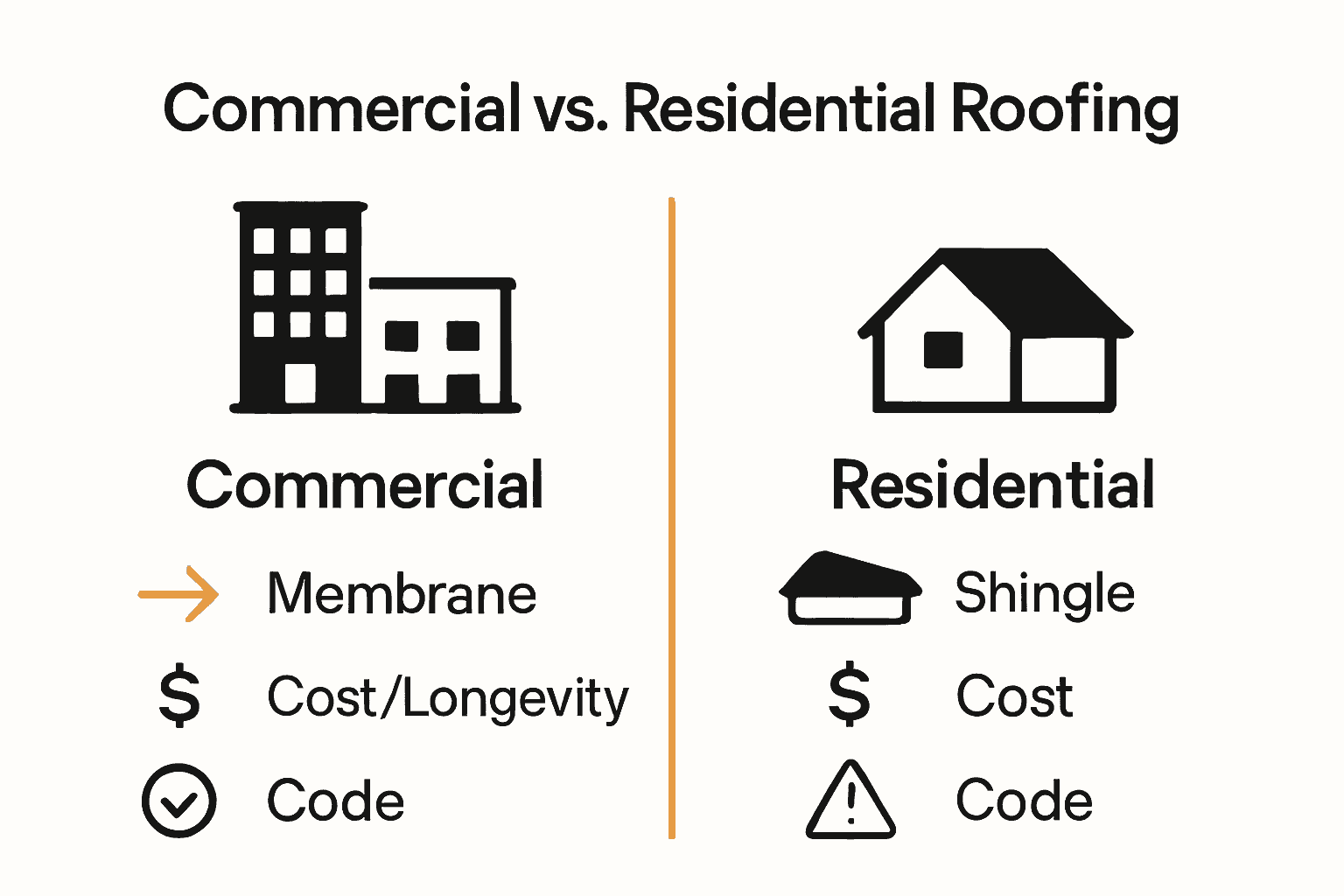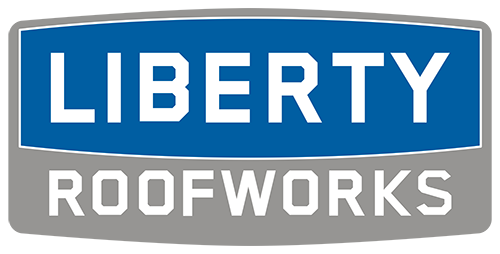Did you know that almost 60 percent of commercial roofs in the US rely on flat, membrane systems instead of shingles? Choosing between commercial and residential roofing goes far beyond style or curb appeal. Roofs serve as your building’s first shield against the elements, yet their materials, shape, cost, and regulations can be dramatically different. Understanding these contrasts helps property owners make smart, long-lasting choices for their buildings.
Key Takeaways
| Point | Details |
|---|---|
| Roofing Types | Residential roofs are typically sloped with aesthetic materials, while commercial roofs are flat and focus on functionality and waterproofing. |
| Materials Used | Residential roofing employs shingles and tiles for visual appeal, whereas commercial roofing uses single-ply membranes and modified bitumen for durability and efficiency. |
| Installation Complexity | Residential roof installations are generally straightforward, while commercial projects are complex, requiring specialized crews and advanced machinery. |
| Cost and Longevity | Residential roofs range from $10,000 to $25,000 with a lifespan of 20-25 years; commercial roofs can exceed $100,000, lasting 15-30 years but requiring more frequent maintenance. |
Table of Contents
- Defining Commercial And Residential Roofing
- Key Differences In Roof Materials Used
- Installation Processes Compared Side By Side
- Cost, Longevity, And Maintenance Factors
- Legal Codes And Safety Requirements Explained
Defining Commercial And Residential Roofing
When it comes to roofing, not all systems are created equal. According to research from industry experts, residential roofing and commercial roofing represent two distinctly different approaches to protecting buildings. Residential roofs typically feature sloped designs with materials like shingles, tiles, or metal, prioritizing both functional protection and aesthetic appeal. In contrast, commercial roofs are predominantly flat, engineered to support heavy equipment and designed with a primary focus on practicality and comprehensive waterproofing.
The structural differences extend far beyond simple design preferences. As research indicates, residential roofing follows residential building codes (IRC), characterized by steep pitches and relatively straightforward structural requirements. Commercial roofs from our guide on best roofing systems, however, must adhere to more complex International Building Code (IBC) standards. These rigorous requirements include:
- Higher load-bearing capacities
- More intricate drainage systems
- Enhanced structural reinforcement
- Advanced waterproofing technologies
While residential roofing emphasizes visual harmony with the home’s architecture, commercial roofing prioritizes durability, efficiency, and long-term performance. The materials, installation techniques, and maintenance strategies differ dramatically between these two roofing categories, reflecting their unique functional demands and environmental challenges.
Key Differences In Roof Materials Used
When it comes to selecting roofing materials, residential and commercial properties demand vastly different approaches. According to research, residential roofing typically incorporates materials like asphalt shingles, tile, metal, and wood shakes, prioritizing both aesthetic appeal and functional durability. These materials are chosen to complement the home’s architectural style while providing reliable protection.
In contrast, our guide on essential roofing materials reveals that commercial roofing materials are engineered with a more utilitarian focus. Research indicates commercial roofs predominantly utilize single-ply options such as:
- EPDM (Ethylene Propylene Diene Monomer) membranes
- TPO (Thermoplastic Polyolefin) roofing
- PVC membranes
- Modified bitumen systems
- Built-up roofing
These commercial roofing materials are specifically designed for maximum performance, offering critical benefits like enhanced UV resistance, energy efficiency, and superior waterproofing. While residential materials emphasize visual charm, commercial roofing materials prioritize long-term functionality, durability, and cost-effectiveness. The selection process involves carefully weighing factors like climate exposure, building usage, maintenance requirements, and potential energy savings.
Installation Processes Compared Side By Side
Roofing installation is far from a one-size-fits-all process. According to industry research, residential roofing and commercial roofing installations represent dramatically different approaches in complexity, duration, and technical requirements. Residential roof installations are typically straightforward, with smaller crews completing the project in just a few days, focusing on efficiency and minimal disruption to the homeowner’s daily life.
Our comprehensive roofing guide reveals the stark contrast with commercial roofing installations. These projects are significantly more complex, often requiring:
- Multiple installation phases
- Advanced heavy machinery
- Specialized technical crews
- Intricate layer systems including:
- Vapor barriers
- Insulation layers
- Base sheets
- Membrane applications
- Reflective protective coatings
Commercial roof installations demand advanced technical skills, with specialized techniques like hot-mop applications, torch-down methods, and TPO welding. The process typically spans weeks, not days, and requires extensive coordination, safety protocols, and precision engineering. While residential installations prioritize speed and aesthetic integration, commercial installations focus on long-term performance, structural integrity, and meeting rigorous building code requirements. Each project becomes a carefully orchestrated technical challenge, balancing efficiency, durability, and specialized expertise.

Cost, Longevity, And Maintenance Factors
Navigating the financial landscape of roofing requires understanding the significant differences between residential and commercial roofing investments. According to research, residential roofing costs typically range from $10,000 to $25,000, with material prices varying from $4 to $15 per square foot depending on choices like asphalt shingles, metal, or tile. These investments are generally more predictable and manageable for homeowners.

Our comprehensive guide on roofing materials highlights the stark contrast with commercial roofing economics. Commercial roofing projects can escalate quickly, with total costs ranging from $20,000 to over $100,000, and per-square-foot expenses between $5 and $18 for materials like TPO, EPDM, and modified bitumen. These higher costs reflect the complexity and specialized requirements of commercial installations.
Longevity and maintenance present another critical comparison point. Research indicates that:
- Residential roofs typically last 20-25 years
- Commercial roofing systems have a lifespan of 15-30 years
- Commercial roofs require more frequent professional inspections
- Proactive maintenance is crucial to prevent:
- Water pooling
- Membrane failure
- Structural deterioration
While residential roofs demand periodic maintenance, commercial roofing systems need systematic, professional intervention to ensure their extended performance and structural integrity. The investment in regular maintenance can significantly impact the roof’s longevity, preventing costly emergency repairs and premature replacement.
Legal Codes And Safety Requirements Explained
Navigating the legal landscape of roofing reveals profound differences between residential and commercial projects. Building codes serve as the critical framework that distinguishes these two roofing domains, with each type subject to unique regulatory requirements that ensure safety, structural integrity, and performance standards.
Our comprehensive roofing systems guide highlights the significant regulatory distinctions. Residential roofing follows the International Residential Code (IRC), which provides more flexible guidelines with less complex structural demands. Commercial roofing, in contrast, must rigorously adhere to the International Building Code (IBC), which imposes substantially more stringent requirements:
- Stricter structural load specifications
- More comprehensive fire rating standards
- Complex drainage system regulations
- Advanced engineering performance metrics
- Detailed safety compliance protocols
Safety requirements present another critical differentiator. According to OSHA standards, commercial roofing demands comprehensive fall protection systems, including:
- Mandatory guardrail installations
- Professional safety net deployments
- Personal fall arrest system requirements
- Detailed worker protection plans
While residential roofing allows more flexibility in fall protection under Subpart M, commercial projects require meticulous safety planning. These stringent regulations reflect the higher risks and complex working environments inherent in commercial roofing installations, prioritizing worker safety and structural reliability above all else.
Here’s a comparison of the primary legal codes and safety requirements for residential and commercial roofing:
| Category | Residential Roofing | Commercial Roofing |
|---|---|---|
| Building Code | IRC (International Residential Code) | IBC (International Building Code) |
| Structural Requirements | Simpler, less complex | Stricter, more complex |
| Fire Rating Standards | Basic compliance | Comprehensive standards |
| Drainage Regulations | Minimal | Detailed, mandatory |
| Safety Protocols | Flexible fall protection (OSHA Subpart M) |
Guardrails Safety nets Personal fall arrest systems |
| Documentation | Basic permits | Extensive documentation |
Solve Your Roofing Challenges with a Trusted Local Expert
Struggling to decide between commercial and residential roofing options? The difference in materials, regulations, and maintenance can make your choice feel overwhelming, especially when your property’s safety and investment are on the line. This guide highlighted how each roofing type requires very specific solutions, whether you are concerned about the right materials for longevity or compliance with strict building codes and safety requirements.
At Liberty Roofworks, our team specializes in both residential roof repair and replacement as well as commercial roofing services. We combine technical expertise and local knowledge to make complexity simple for property owners in Charlotte, NC. Unsure which roofing solution best fits your situation? Visit Liberty Roofworks today for a free consultation and experience why choosing the right expert now will protect your property long-term.
Frequently Asked Questions
What is the main difference between commercial and residential roofing?
Residential roofing typically features steep slopes and aesthetic materials like shingles or tiles, while commercial roofing is mostly flat and designed for functionality with materials such as EPDM and TPO.
What materials are commonly used for residential and commercial roofing?
Residential roofs often use materials like asphalt shingles, metal, and tiles, whereas commercial roofs typically utilize single-ply membranes like EPDM, TPO, and PVC for durability and performance.
How do the installation processes differ between residential and commercial roofing?
Residential roofing installations are generally simpler and completed within a few days, while commercial installations are complex, requiring heavy machinery and extensive safety protocols, often taking weeks to finish.
What are the typical costs and maintenance considerations for residential versus commercial roofing?
Residential roofing costs range from $10,000 to $25,000, while commercial roofing can exceed $20,000. Maintenance for residential roofs involves periodic inspections, while commercial roofs require more frequent professional maintenance to address specific challenges like water pooling.
